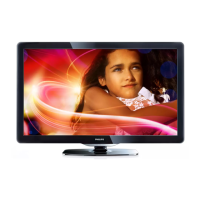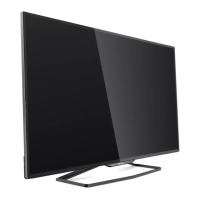Do you have a question about the Philips 47PFL3704D and is the answer not in the manual?
Details about the TV's energy consumption, model, and serial numbers.
Guidelines on how to clean and protect the TV screen to avoid damage.
Information on recycling packaging and disposing of the TV responsibly.
Important warnings and cautions regarding product safety and use.
Identifies the buttons and indicators on the TV's side panel.
Explains the function of each button on the remote control.
Guidance on safely and optimally placing the television.
Instructions for inserting batteries into the remote control.
Steps for connecting TV to antenna or cable sources.
Tips for routing and organizing cables for a tidy setup.
Initial steps to power on and configure the TV for first-time use.
How to power the TV on, put it in standby, or turn it completely off.
Methods for changing TV channels using the remote or TV controls.
Instructions for controlling the TV's audio volume and muting.
Accessing frequently used settings quickly via the OPTION button.
How to adjust picture and sound parameters for optimal viewing.
Adjusting the aspect ratio of the displayed image.
Detailed explanation of various picture adjustment options available.
Guide to adjusting audio settings like equalizer, balance, and volume leveling.
Explanation of available sound adjustments and their effects.
Applying preset picture and sound settings for different scenarios.
Organizing and accessing preferred TV channels easily.
Configuring the TV's internal clock and sleep timer functions.
Setting a timer for the TV to automatically switch to standby.
Preventing access to certain programs or channels based on ratings.
How to set up or modify the personal identification number for security features.
Enabling features to lock TV operation, such as 'Lock after' or 'Timer'.
Method to lock specific channels, making them inaccessible without a PIN.
Using the V-chip to control program access based on age and content ratings.
Controlling movie viewing based on MPAA or Canadian rating systems.
Locking access to digital programs based on downloaded regional ratings.
Enabling and customizing the display of closed captions for programs.
Choosing appropriate captioning services for analog and digital channels.
Configuring the appearance of digital captions (size, font, color).
Accessing photos and music files stored on a USB drive.
Steps to connect and recognize a USB device for media playback.
Proper procedure for safely removing a USB device.
Optimizing TV display for high-definition sources.
Setting the TV's mode selection for HD compatibility.
Playing audio files from a connected USB device.
Adding background music to a picture slideshow.
Connecting and configuring the TV to function as a computer monitor.
Enabling one-touch play/standby for connected EasyLink devices.
Viewing product demonstrations to understand TV features.
Choosing the display language for the TV's menus and on-screen text.
Configuring the TV's location for optimal picture and sound settings.
Performing an automatic scan to find and tune available TV channels.
Adjusting antenna and TV settings to improve signal reception.
Removing and re-adding channels from the TV's memory.
Resetting picture and sound settings to factory defaults.
Configuring how emergency alert messages are displayed on the TV.
Viewing the installed software version on the TV.
Requirements for downloading and preparing TV software updates.
Steps to obtain software updates from the Philips website.
Procedure for installing new software onto the TV.
Diagrams showing the various input and output connectors on the TV.
Instructions for connecting a DVD player using composite video/audio cables.
Connecting digital devices using HDMI cables for high-quality input.
Connecting devices using HDMI-DVI and digital audio outputs.
Connecting a set-top box using composite video and audio inputs.
Connecting devices using component YPbPr and analog audio inputs.
Connecting a home theater amplifier for enhanced audio output.
Connecting a computer to the TV via S-Video or DVI connectors.
Detailed steps for connecting a PC using a DVI cable.
Detailed steps for connecting a PC using an HDMI cable.
Solutions for issues with the TV not powering on or showing indicator lights.
Troubleshooting HDCP authentication errors when using HDMI.
Resolving issues where no audio is heard from a connected PC.
Steps to take when the TV is unresponsive to remote control commands.
Fixing picture display issues like distortion or black bars.
Troubleshooting color inaccuracies with component video connections.
General solutions for complete loss of video or audio signal.
Information on supported file types, formatting, and limitations for USB content.
Troubleshooting common problems when connecting digital cameras via USB.
Requirements and compatibility for USB mass storage devices.
Details on the TV's visual processing features and specifications.
Information about the TV's audio capabilities and settings.
Features that simplify the user experience, like video modes and media playback.
Overview of supported input and output connections for various devices.
Details on what the limited warranty covers and for how long.
Defines who is eligible for the product warranty.
Specifies the conditions under which the company will repair, exchange, or refund.
Lists exclusions and limitations to the warranty coverage.
| aspect ratio | Widescreen |
|---|---|
| brightness | 500 cd/m² |
| dynamic screen contrast | 29000:1 |
| response time | 5 ms |
| viewing angle | 178º (H) / 178º (V) |
| panel resolution | 1920x1080p |
| ambient temperature | 5 °C to 40 °C |
|---|---|
| mains power | 110-240V, 50-60Hz |
| power consumption | 275 W |
| standby power consumption | < 1 W |
| diagonal screen size | 47 inch / 119 cm |
|---|---|
| visible screen diagonal | 46.96 inch |
| set dimensions (W x H x D) | 45.28 x 28.87 x 4.10 inch |
| set dimensions with stand (W x H x D) | 45.28 x 31.40 x 12.20 inch |
| box dimensions (W x H x D) | 50.55 x 32.87 x 15.04 inch |
| weight incl. packaging | 90.39 lb |
| product weight | 59.92 lb |
| product weight (+stand) | 74.82 lb |
| VESA wall mount compatible | 400 x 400 mm |












